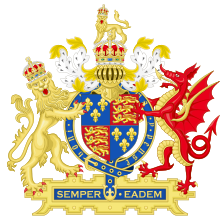
Royal coat of arms of England, 1558–1603
|
The Act of Accord was a statute of Parliament enacted on 25 October, 1460. Under the terms of the Act, Henry VI was confirmed as king, but after his death the throne was to pass to Richard, Duke of York, and his heirs.
BACKGROUND
The Act of Accord must be seen as part of the long struggle for supremacy between the houses of York and Lancaster that occupied much of the 15th century in England. King Henry VI was the head of the House of Lancaster, while the head of the House of York was Richard, Duke of York. Major outbreaks of violence occurred as early as 1455, when Richard and Henry's men met at the firstBattle of St Albans. Following that battle, Henry VI suffered a recurrence of the mental illness which was to plague him all his life, and for a time was clearly incapable of exercising authority. So Richard of York was instated as Protector, which in practice meant that he was king in all but name.
The Act of Accord must be seen as part of the long struggle for supremacy between the houses of York and Lancaster that occupied much of the 15th century in England. King Henry VI was the head of the House of Lancaster, while the head of the House of York was Richard, Duke of York. Major outbreaks of violence occurred as early as 1455, when Richard and Henry's men met at the firstBattle of St Albans. Following that battle, Henry VI suffered a recurrence of the mental illness which was to plague him all his life, and for a time was clearly incapable of exercising authority. So Richard of York was instated as Protector, which in practice meant that he was king in all but name.
Henry recovered, but conflict ensued between supporters of Henry and Richard. The main bone of contention was whether Henry's infant son, Prince Edward, should succeed Henry upon his death, or whether the throne should pass to Richard and his heirs. Queen Margaret (Margaret of Anjou) refused to accept any solution that deprived her son of his inheritance. The queen began to exercise more and more control over affairs of state, and she convinced Henry to overturn all appointments made by the Duke of York in his position as Protector.
The Duke was sent to Ireland as Lieutenant, but he quickly returned and gathered support for armed conflict. Several battles followed, in which the Lancastrians were triumphant, leaving Richard to scamper back to Ireland. However, the Duke was not finished. In 1460 the Duke of Warwick, the most powerful supporter of the Lancastrian cause, raised fresh troops. At the Battle of Northampton Warwick's army inflicted a heavy defeat upon the king. Once again Henry suffered yet another outbreak of mental illness. With the incapacitated king in tow, the Lancastrian army marched to London.
Richard of York returned to London and called Parliament to assemble. To the consternation of his own supporters, Richard claimed the throne for himself. Richard may well have thought this the logical outcome of his struggle with King Henry, but most of his followers seemed to regard the conflict's central aim as the removal of Henry's least popular councilors, and the diminishment of Queen Margaret's power. Richard produced genealogies aimed at supporting his claim to the throne through Lionel, Duke of Clarence, son of Edward III. Though Parliament conceded that Richard had the better claim to the throne, they were unwilling to depose him outright. A compromise was reached, and that compromise was the Act of Accord.
Under the terms of the Act of Accord, Henry's son Edward was disinherited, in favour of Richard and his heirs. Richard was named Protector of the Realm once more, and given powers which made him, in effect, a king without the title.
Consequences of the Act of Accord
It was never likely that the forceful Margaret of Anjou was going to accept the Act of Accord, and so it proved. She gathered supporters to her, and raise a fresh army. They met Richard's force at the Battle of Wakefield on Christmas Day, 1460. The Lancastrian army was routed, and Richard was killed. His youngest son, Edmund was captured and executed.
Unfortunately for the queen, the Duke's eldest son, Edward, Earl of March, was very much at large. Edward gathered fresh troops on the Welsh Marches, and after a series of battles, finally routed the queen's army at Towton. Edward was crowned king as Edward IV in June, 1461.
Consequences of the Act of Accord
It was never likely that the forceful Margaret of Anjou was going to accept the Act of Accord, and so it proved. She gathered supporters to her, and raise a fresh army. They met Richard's force at the Battle of Wakefield on Christmas Day, 1460. The Lancastrian army was routed, and Richard was killed. His youngest son, Edmund was captured and executed.
Unfortunately for the queen, the Duke's eldest son, Edward, Earl of March, was very much at large. Edward gathered fresh troops on the Welsh Marches, and after a series of battles, finally routed the queen's army at Towton. Edward was crowned king as Edward IV in June, 1461.
No comments:
Post a Comment